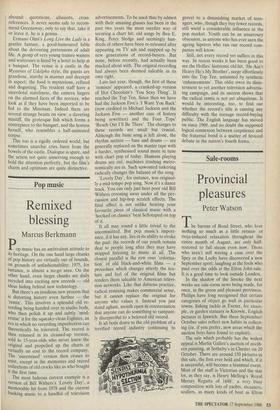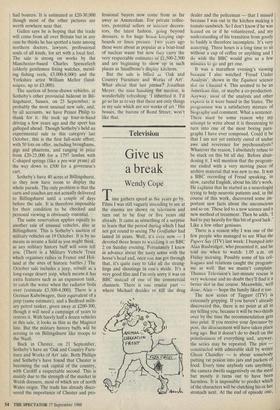Sale-rooms
Provincial pleasures
Peter Watson
The barons of Bond Street, who love nothing so much as a little retsina- or rioja-induced relaxation throughout the entire month of August, are only half- restored to full steam even now. Those who aren't still waving a cane over the Spey or the Lochy have discovered a new September sport: laughing at the fools who paid over the odds at the Elton John sale. It is a good time to look outside London.
In the shadow of the Smoke the next weeks see sale-room news being made, for once, in the green and pleasant provinces. Phillips have long recognised that certain categories of object go well in particular towns: fishing tackle in Exeter, for exam- ple, or garden statuary in Knowle, English pictures in Ipswich. But these September/ October sales reflect new habits in collect- ing (or, if you prefer, new areas which the auction boys have found to exploit).
The sale which probably has the widest appeal is Martin Gallen's auction of north- ern painting, at Sotheby's in Chester on 20 October. There are around 150 pictures in this sale, the first ever held and which, if it is successful, will become a biannual event. Most of the stuff is Victorian and the star lot, as they say, is Henry Melling's 'Royal Mersey Regatta of 1848', a very busy composition with lots of yachts, steamers, scullers, as many kinds of boat as Elton had boaters. It is estimated at £20-30,000 though most of the other pictures are worth nowhere near that.
Gallen says he is hoping that the trade will come from all over Britain but in any case he thinks he has spotted a taste among northern doctors, lawyers, professional souls of all kinds, for art with a local feel. The sale is strong on works by the Manchester-based Charles Spencelayh (elderly gentlemen fixing watches, mend- ing fishing reels, £3,000-8,000) and the Yorkshire artist William Mellor (land- scapes, up to £3,000).
The auction of horse-drawn vehicles, at Sotheby's other provincial hideout in Bil- lingshurst, Sussex, on 23 September, is probably the most unusual new sale, and, by all accounts, we have Prince Philip to thank for it. He took up four-in-hand driving a few years ago and the sport has galloped ahead. Though Sotheby's held an experimental sale in this category last October, this is the first full-scale effort, with 50 lots on offer, including broughams, gigs and phaetons, and ranging in price from £20-25,000 for a 1797 landau with C-shaped springs (like a pre-war pram) all the way down to £500 for a governess's cart.
Sotheby's have 40 acres at Billingshurst, so they now have room to display the whole parade. The only problem is that the carts and coaches are not actually delivered to Billingshurst until a couple of days before the sale. It is therefore impossible for their condition to be checked and personal viewing is obviously essential.
The same reservation applies equally to another sale of unusual vehicles, also at Billingshurst. This is Sotheby's auction of military vehicles on 19 October. It is by no means as arcane a field as you might think, as any military history buff will soon tell you. (There is a Military Vehicle Trust which organises rallies in France and Hol- land at the sites of historic battles.) The October sale includes a jeep, rebuilt as a long-range desert jeep, which means it has extra features such as an expansion tank, to catch the water when the radiator boils over (estimate £3,500-4,000). There is a German Kubelwagen, their equivalent of a jeep (same estimate), and a Bedford milit- ary petrol tanker, given away at £200-300, though it will need a campaign of years to restore it. With barely half a dozen vehicles in this sale, it looks as thin as the Maginot line. But the military history buffs will be zeroing in on Billingshurst like troops to the Naafi.
Back in Chester, on 21 September, Sotheby's have an 'Oak and Country Furn- iture and Works of Art' sale. Both Phillips and Sotheby's have found that Chester is becoming the oak capital of the country, with Cardiff a respectable second. This is mainly due to the strength of the market in Welsh dressers, most of which are of north Wales origin. The trade has already disco- vered the importance of Chester and pro- fessional buyers now come from as far away as Amsterdam. For private collec- tors, potential sellers or interior decora- tors, the latest fashion, going beyond dressers, is for huge house keeping cup- boards or linen presses. Iwo years ago these were about as popular as a boat-load of nuclear waste but now they carry the very respectable estimates of £1,500-2,500 and are beginning to show up in such places as Smallbone's display kitchens.
But the sale is billed as 'Oak and Country Furniture and Works of Art'. What about that last pnrase? Jonathan Meyer, the man handling the auction, is wonderfully refreshing: 'I inherited it. I'd go so far as to say that there are only things in my sale which are not works of art.' His bosses, the barons of Bond Street, won't like that.



































































 Previous page
Previous page